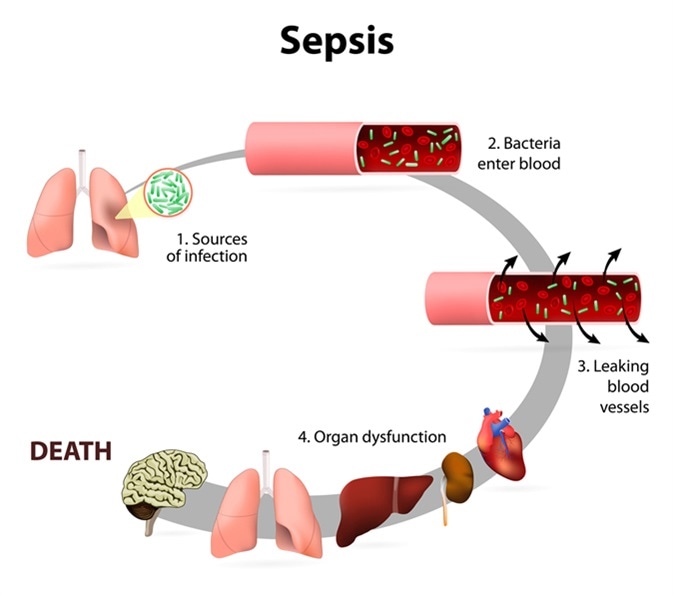Pediatirc/ Septicemia
Bacteremia
Bacteremia is just an invasion of the bloodstream by bacteria. Occurs when bacteria enter
the bloodstream like during teeth brushing or arterial catheterization or may occur through
a wound or infection, or through a surgical procedure or injection.
Bacteremia may be transient and cause no symptoms and resolve without treatment,
OR it may produce fever and other symptoms of infection.
In some cases, bacteremia l eads to septicemia and ultimately to septic shock, a potentially
life -threatening condition.
Septicemia and sepsis
Septicemia is the presence of bacteria in the blood (bacteremia with its toxins ) leading tosevere body immune inflammatory response to it and is often associated with severe
disease leading to the term sepsis . Septicemia is the pathogenesis of the sepsis syndrome .
Its alternative name is blood poisoning (bacteremia with toxins ).Septicemia or sepsis is a
serious, life -threatening infect ion that gets worse very quic kly leading to septic shock.
So sepsis is the syndrome of severe illness .
Sepsis is caused by reaction and response of the body to overwhelming infection of the
bloodstream by toxin -producing bacteria (septicemia ) .Its alternative name Systemic
inflammatory response syndrome (SIRS).
Sepsis is caused by and follow bacterial infection that can originate anywhere in the body ;
as complication . Common sites include the following:
1. The kidneys (upper urinary tract infe ction)
2. The liver or the gall bladder
3. The bowel (usually seen with peritonitis)
4. The skin (cellulitis)
5. The lungs (bacterial pneumonia) .
It may come before or at same time of onset of focal infection as in
1. Meningitis2. Osteomylitis
3. Infective endocarditis.
The infection is often confirmed by a positive blood culture, though blood cultures
may be negative in 10% .
In sepsis, if blood pressure drops, it result s in septic shock. Major organs and systems,
including the kidneys, liver, lungs, and central nervous system, may stop functioning
normally specially if shock supervene .
.Sepsis is often life -threatening , especially in people with a weakened immune system or
other chronic medical illnesses .
Risk factors for sepsis ;
1. Age ;preterm baby, & fullterm more than infants less than 2 years of age.2. Immunodeficiency ; like neutropenia, aseplenia, sickle cell disease ,AIDS,B -cell
defect.
3.Debilitating illnesses like malignancy,nephrosis,malnutrition, galactosemia
4.highly infectious virulent m.o . as in contact with meningitis patient
N.meningitis,H.influenza .
5.medica l indwelling instruments ; ve ntriculoatrial or venticuloperitonial shunt,
pro sthetic heart valves,urinary catheters.
The microorganisms type of sepsis depend on the age and the immunity :
In neonatal sepsis , Group B Strept, E.coli, Staph aureus,staph epidermidis, Listeria.In preterm; staph epidermidis, pseudomonas is common even without focal infections .
In older infants < 2 yr with no localizing infection the m.o .are pneumo co ccus,
meningococcus, salmonella, S. aureus, group A strept, and H.influenza if no vaccination.
Infants with galctosemia and pyelonephritis may get gram -ve bacteremia.
Sepsis may occur in immune deficiency patients without focal infection, even with
opportunistic m.o. like pseudomonas,fungi ,and by a wide variety of m.o.; G -ve, G+ve,
anaerobic m.o, …
Pathophysiology of sepsis and septic shock ;
It is the body response to microbial products like antigens which trigger immune respnoseby inflammatory cytokines that initiate cascade of responses producing clinical
manifestation of sepsis . Clinical manifestations include; fever , profound vasodilatatio n and
hypotension. Lung may responde by acute respiratory distess syndrome and failure of gas
exchange which is 90 -100% fatal. Multi -organ -system failure may occur with disseminated
intravascular coagulation(DIC)
Clinical features of sepsis ;
Early signs ; Fever or hypothermia as in neonate.
Chills,
Agitation,
confusion ,lethargy
Hyperventilation
Tachycardia
Hypotension
Peripheral vasodilatation
petechiae and purpura,
late s igns of sepsis; septic shock ;
profound hypotension
cold clammy skin,mottled skin,
cyanosis,
poor capillary refill
weak pulse,
lethargy and com a
Tests that can confirm infection include:
Blood culture 90% +ve
Blood gases ; lactic acidosis
CBC neutropenia,thrombocytopenia,anemia
Clotting studies ; prolonged times due to DIC
o PT
o PTT
o Fibrinogen levels decreased and fibrin split products increased
CSF culture
Platelet count
Urine culture
Treatment of septicemia
Septicemia is a serious condition that requires a hospital stay. You may be admitted to anintensive care unit (ICU).
You may be given:
Antibiotics to treat the infection ;for g -ve sepsis,give aminoglycoside plus anti -
pseudomonas; as gentamicin and ticarcillin -clavulinate or ceftazidime . Vancomycin for staph.aureus or epidermidis,
flagyl or clindamycin for anaerobic m.o.sepsis like in perforated viscus,
Fluids IV and
medicines by I V to maintain the blood pressure like dopamine and dobutamine, or
epinephrine
Oxygen
Plasma or other blood products to correct any clotting problems
Outlook (Prognosis) of septicemia
The outlook depends on the bacteria involved and how quickly the patient is hospitalizedand treatment begins. The death rate is high -- more than 50% if shock reached and reach
90 -100% if ARDS developed , multi -organs failure or DIC occurs. Septicemia due to
meningococci can lead to shock or adrenal collapse ( Waterhouse -Friderichsen syndrome ).
When to Contact a Medical Professional
Septicemia is not common but it is very serious. Diagnosing it early may prevent septicemiafrom worsening to shock.
Seek i mmediate care if:
A person has a fever, shaking chills, and looks very ill , hyperventilation.
Any person who has been ill has changes in mental status like agitation, lethargy,
confusion
There are signs of bleeding into the skin ; purpura or petech iae
Call your health care provider if your child's vaccinations are not up -to -date.
Prevention
Getting treated for focal infections can prevent septicemia. The Haemophilus influenza B(HIB) vaccine and S. pneumoniae vaccine have already reduced the number of septicemia
cases in children. Both are recommended childhood immunizations.
In rare cases, people who are in close contact with someone who has meningitis may be
prescribed preventive antibiotics.


Comments
Post a Comment